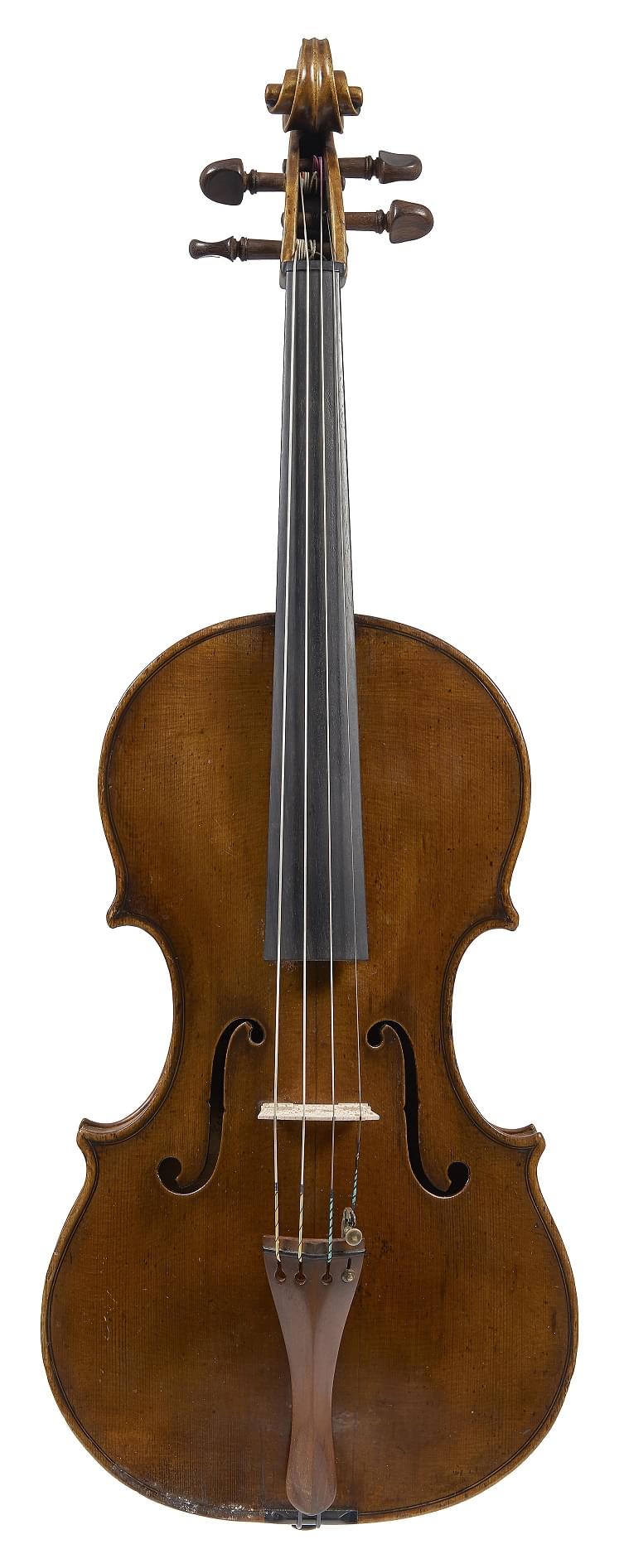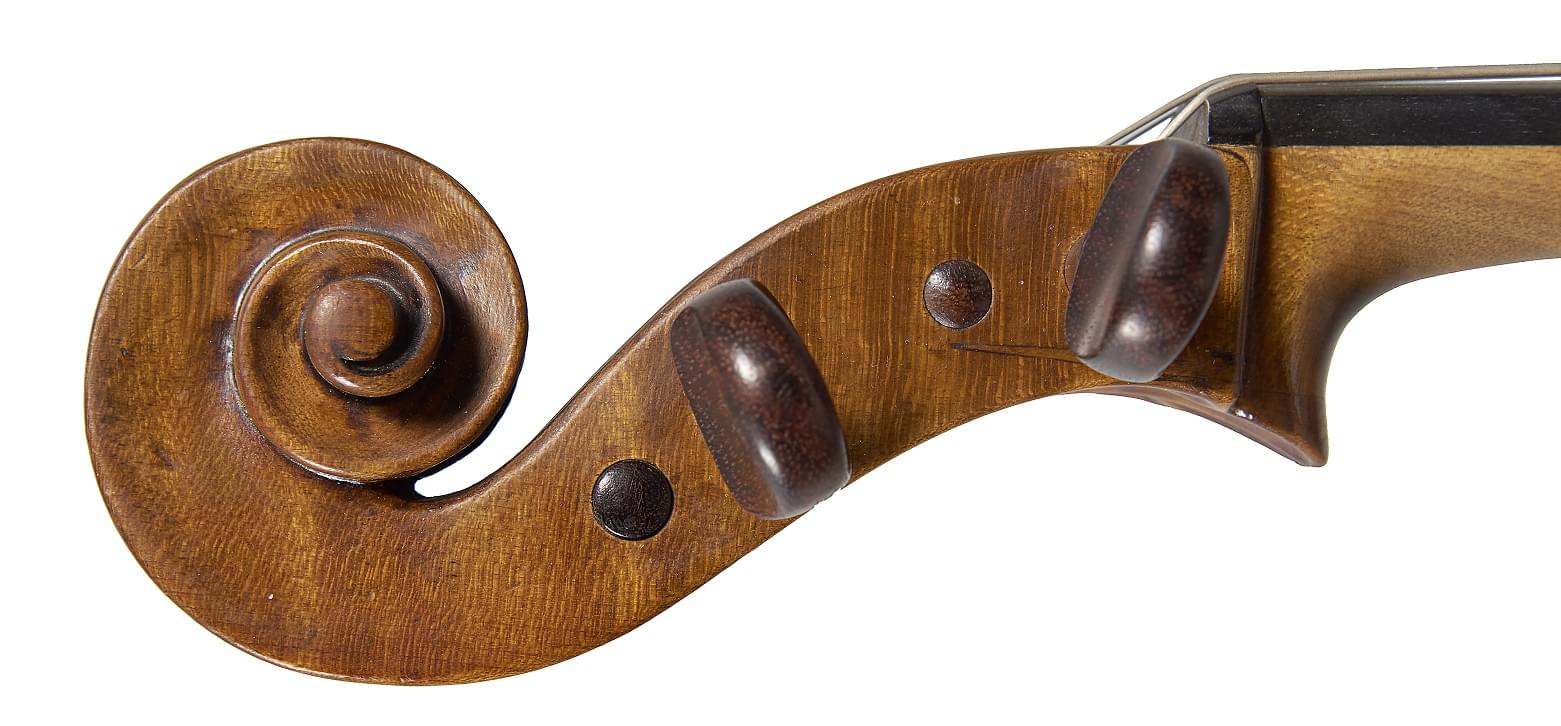A viola by the Voller Brothers
The name Voller can provoke both excitement and trepidation. The English brothers William, Alfred and Charles have a well-deserved reputation as ingenious copyists, and are the very last words the owner of a treasured old Italian instrument might wish to hear. But once their work is identified, and separated from what might admittedly be a slightly disturbing history, it is time to enjoy the skill and artistry that these naturally reclusive makers very frequently display. Some of their work is undistinguished, admittedly, churned out for quick returns and with little consideration. Often though, an exceptional instrument stops you in your tracks and makes you marvel. This viola is an example. From any point of view it is a distinguished piece of work, carried out with great skill, ingenuity and sensitivity, capturing almost perfectly the essence of an instrument two hundred years older than it is, and the definitive charm of Italian work of the classical period.
What is particularly interesting is that this is a relatively late work by the Vollers; dendrochronology shows that it was made after 1922, the date of the youngest growth of the pine in the front, and therefore after the death of the middle brother Alfred in 1918, at the age of 61. Genuine labels of the brothers are very rare, and almost non-existent after the very earliest period in the 1890s, since their instruments almost invariably bear fictitious dates as well as names. A chronology of the brothers’ work is very difficult to establish, but knowing that this viola was the work of William and Charles is very helpful. William died in 1933, aged 79, and his younger brother Charles lived on until 1949, when he died aged 84. Given the vigour and assurance of the workmanship in this Tononi copy, it seems reasonable to attribute it in the main, if not entirely, to Charles.
It is clearly a copy of a Giovanni Tononi, and a model that the brothers used more than once. They must certainly have had access to an original example through their associations with the London trade at that period, from 1890-1930, specifically with George Hart, for whom they worked early in their careers.
'This viola is a distinguished piece of work, carried out with great skill, ingenuity and sensitivity.'
The Tononi model is a beautiful one. There are several genuine examples extant, any of which may have been the inspiration for the Voller copy. Typically, the form is Amatise, and the workmanship suitably precise. Giovanni Tononi was by far the best of the Bolognese makers in the eighteenth century, and his viola model an ideal 41cm long, a perfect pattern for modern instruments.
The arching is beautifully rendered, faithfully imitating the comparatively high, rounded curves and emphatic edge channel of the original, with beautifully cut open Amatise soundholes, set characteristically close together and upright. One of the indicators of Voller authorship is that the circles of the ‘F’s are knife-cut, rather than pierced with a circular cutter as the original would have been.
Another clear indication of their work is the use of ebony for the black veneers of the purfling, again inappropriate for a genuine Tononi. Yet another intriguing point is the tiny ‘black spot’ that appears on most of the wood surfaces under the varnish. Unobtrusive enough in this deliberately aged and patinated instrument, the tiny irregular marks may indicate acid treatment, which was probably the Voller’s method for darkening and visually ageing the wood. Significantly, the head does not show these marks, and it is very possible that it is an older piece, ‘salvaged’ from a donor instrument, which was also a regular practice of the Vollers. Nevertheless the style and workmanship of the scroll is very much in tune with the rest of the instrument, and the repair to the cheek below the C and G pegs may equally imply that the Vollers simply made use of an already well-aged and darkened piece of wood, despite it having been pierced with a nail in its previous manifestation, like the wood from an old bridge used by Rocca, or the billiard table that Panormo is said to have plundered for violin parts. The cello-style cheeks are however not an authentic Tononi feature. Why the Vollers would have adapted the original design in this way is not clear, but it is not easy to attribute the head to any other hand.
'The arching is beautifully rendered, faithfully imitating the comparatively high, rounded curves and emphatic edge channel of the original.'
One last surprising and, in the circumstances, pleasing feature of the instrument is the fact that it has two labels. One, in the conventional position beneath the bass ‘F’, is a convincing facsimile of Joannes Tononi, dated 1737. But adhering to the lower treble rib on the inside is another, made out in the name of Pietro Tononi, 1703. Pietro was certainly a member of the Tononi family, born in 1647, but his activity as a violin maker is in doubt. It is a typical gesture of the forger to use the most obscure name consistent with high value and interest. Examples of authenticated Pietro Tononi work are non-existent, making it impossible to compare or dispute the authenticity of the copy. It is a common strategy of copyists in any field. The Pietro ticket is probably the label that the Vollers themselves originally placed beneath the ‘F’, and is consistent in form with other fictional labels that they printed up. The present, more prominent label is probably the work of a subsequent speculator, who presumably felt that changing the attribution from the little-known Pietro to the more valuable Giovanni, whose work it most clearly represents, would be financially beneficial.
Recent Posts
Categories
- Feature Type
- Instrument Type
-
Maker
- Albani, Mathias (2)
- Amati, Andrea (8)
- Amati, Antonio & Girolamo (6)
- Amati, Girolamo II (6)
- Amati, Nicolò (6)
- Balestrieri, Tommaso (3)
- Banks, Benjamin (1)
- Bazin, Charles Nicolas (1)
- Bergonzi Family (1)
- Bergonzi, Carlo (2)
- Bergonzi, Michele Angelo (2)
- Bernardel, Auguste Sébastien Philippe (2)
- Bisiach, Leandro (2)
- Bultitude, Arthur Richard (1)
- Bussetto, Giovanni Maria del (1)
- Camilli, Camillo (2)
- Cappa, Gioffredo (2)
- Carcassi, Lorenzo & Tomaso (1)
- Ceruti, Giovanni Battista (3)
- Chanot, George Adolph (1)
- Cuypers, Johannes Theodorus (1)
- Dalla Costa, Pietro Antonio (1)
- Deconet, Michele (1)
- Fendt, Bernard Simon II (1)
- Fendt, Bernhard Simon I (1)
- Gabrielli, Giovanni Battista (1)
- Gagliano, Alessandro (2)
- Gagliano, Ferdinando (1)
- Genova, Giovanni Battista (1)
- Gisalberti, Andrea (1)
- Goffriller, Francesco (1)
- Goffriller, Matteo (1)
- Grancino, Giovanni (4)
- Grancino, Giovanni Battista II (1)
- Guadagnini, Gaetano II (1)
- Guadagnini, Giovanni Battista (7)
- Guarneri 'filius Andreæ', Giuseppe (3)
- Guarneri del Gesù, Giuseppe (5)
- Guarneri of Mantua, Pietro Giovanni (2)
- Guarneri of Venice, Pietro (3)
- Guarneri, Andrea (3)
- Götz, Conrad (1)
- Hill & Sons, W.E. (1)
- Kennedy, Thomas (1)
- Knopf, Carl Heinrich (1)
- Landolfi, Carlo Ferdinando (1)
- Lott, John Frederick (1)
- Lupot, Nicolas (2)
- Mantegazza, Pietro Giovanni (2)
- Mariani, Antonio (1)
- Montagnana, Domenico (2)
- Panormo, Vincenzo Trusiano (1)
- Parker, Daniel (1)
- Peccatte, Dominique (1)
- Platner, Michele (1)
- Pressenda, Giovanni Francesco (1)
- Rayman, Jacob (1)
- Retford, William Charles (1)
- Rivolta, Giacomo (1)
- Rocca, Giuseppe Antonio (2)
- Rota, Giovanni (1)
- Rugeri, Francesco (3)
- Sartory, Eugène (1)
- Scarampella, Stefano (2)
- Schwartz, George Frédéric (1)
- Serafin, Santo (1)
- Sgarabotto, Gaetano (1)
- Sgarabotto, Pietro (1)
- Simon, Pierre (1)
- Stainer, Jacob (3)
- Storioni, Lorenzo (3)
- Stradivari, Antonio (14)
- Stradivari, Francesco (1)
- Stradivari, Omobono (1)
- Tadioli, Maurizio (1)
- Taylor, Michael (1)
- Tecchler, David (2)
- Testore, Carlo Giuseppe (1)
- Tourte, François Xavier (4)
- Tubbs, James (1)
- Voller Brothers (1)
- Vuillaume, Jean-Baptiste (10)
- Watson, William (1)
- da Salò Bertolotti, Gasparo (2)
- Author
- Charity
-
In the Press
- Antiques Trade Gazette (3)
- Archi-magazine.it (1)
- Art Daily (2)
- CNN Style (1)
- Classic FM (2)
- ITV (1)
- Ingles & Hayday (4)
- Liberation (1)
- Life Style Journal (1)
- London Evening Standard (1)
- Paul Fraser Collectibles (1)
- Rhinegold Publishing (1)
- Sotheby's (1)
- Strings Magazine (2)
- Tarisio (2)
- The Fine Art Post (1)
- The Strad (7)
- The Times (1)



